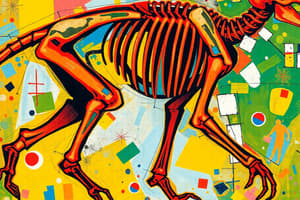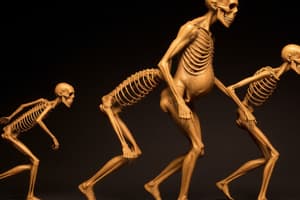Podcast
Questions and Answers
What is the main focus of the Self-Learning Module designed for Grade 11?
What is the main focus of the Self-Learning Module designed for Grade 11?
- Understanding Mathematics in the K to 12 Curriculum
- Mastering the Different Cultures of the Philippines
- Understanding Human Origins and the Capacity for Culture (correct)
- Developing 21st Century Skills in Communication
Which aspect is NOT emphasized in the module's learning goals?
Which aspect is NOT emphasized in the module's learning goals?
- Critical Thinking
- Creativity
- Collaboration
- Physical Education (correct)
Who collaborated in the development of this educational resource?
Who collaborated in the development of this educational resource?
- Private Educational Institutions
- Educators from Pasig City Schools Division (correct)
- International Educators and Researchers
- Local Government Officials
What is one of the 5 Cs mentioned in the module?
What is one of the 5 Cs mentioned in the module?
What role is described for the facilitator of the module?
What role is described for the facilitator of the module?
Which of the following is a key benefit of the learning material?
Which of the following is a key benefit of the learning material?
What should learners be encouraged to do according to the module?
What should learners be encouraged to do according to the module?
Which educational approach does the module utilize for student engagement?
Which educational approach does the module utilize for student engagement?
What is the main requirement according to Republic Act 8293, Section 176 for utilizing government works for profit?
What is the main requirement according to Republic Act 8293, Section 176 for utilizing government works for profit?
What may a government agency impose as a condition for the use of its work?
What may a government agency impose as a condition for the use of its work?
What type of materials are cited as needing permission for their use?
What type of materials are cited as needing permission for their use?
What does the publisher and authors state regarding ownership of borrowed materials?
What does the publisher and authors state regarding ownership of borrowed materials?
Which role is NOT mentioned in the Development Team of the Self-Learning Module?
Which role is NOT mentioned in the Development Team of the Self-Learning Module?
In which year was the first edition of the module published?
In which year was the first edition of the module published?
Which individual is noted as the OIC-Assistant Schools Division Superintendent?
Which individual is noted as the OIC-Assistant Schools Division Superintendent?
Who is responsible for the layout of the Self-Learning Module?
Who is responsible for the layout of the Self-Learning Module?
What is the purpose of the 'Expectations' section in the module?
What is the purpose of the 'Expectations' section in the module?
Which hominid species is known as the 'southern ape'?
Which hominid species is known as the 'southern ape'?
What does the 'Valuing' section of the module emphasize?
What does the 'Valuing' section of the module emphasize?
Which of the following statements correctly describes Homo erectus?
Which of the following statements correctly describes Homo erectus?
What is the significance of human material remains in understanding cultural processes?
What is the significance of human material remains in understanding cultural processes?
What concept states that no culture is superior to any other culture?
What concept states that no culture is superior to any other culture?
Which of the following sections provides a review of previously learned concepts?
Which of the following sections provides a review of previously learned concepts?
Which of these is an expected outcome for students in this lesson?
Which of these is an expected outcome for students in this lesson?
What does culture represent in a society?
What does culture represent in a society?
What is evolution according to the content?
What is evolution according to the content?
Which early ancestor is mentioned as an important figure in the human evolutionary stages?
Which early ancestor is mentioned as an important figure in the human evolutionary stages?
What role does culture play in understanding human origins?
What role does culture play in understanding human origins?
What was the initial state of human beings according to the content?
What was the initial state of human beings according to the content?
Which of the following does NOT contribute to genetic variation?
Which of the following does NOT contribute to genetic variation?
What does the term 'Hominidae' refer to?
What does the term 'Hominidae' refer to?
Which aspect of Darwin's theory is relevant to the understanding of evolution?
Which aspect of Darwin's theory is relevant to the understanding of evolution?
What distinguished Ramapethicus from Dryopethicus?
What distinguished Ramapethicus from Dryopethicus?
Which species is commonly known as 'Lucy'?
Which species is commonly known as 'Lucy'?
What characteristic was common among Australopithecus species?
What characteristic was common among Australopithecus species?
How does the brain size of Hominids compare to that of Australopithecus?
How does the brain size of Hominids compare to that of Australopithecus?
Which Australopithecus species is noted for having a smaller skull than the others?
Which Australopithecus species is noted for having a smaller skull than the others?
What key feature differentiated Homo habilis from Australopithecus?
What key feature differentiated Homo habilis from Australopithecus?
What similarity exists between Homo habilis and Homo Rudolfensis?
What similarity exists between Homo habilis and Homo Rudolfensis?
Which feature best describes Australopithecus africanus?
Which feature best describes Australopithecus africanus?
Study Notes
Understanding Human Origins and the Capacity for Culture
- The module aims to engage Grade 11 students in guided and independent learning about human origins and cultural capacity.
- Designed in accordance with the K to 12 Curriculum, it focuses on the Most Essential Learning Competencies (MELC).
- The learning experience is structured around 21st-century skills: Communication, Collaboration, Creativity, Critical Thinking, and Character.
Human Origins
- Humans evolved from apelike ancestors, indicating a biological legacy.
- Changes influenced lifestyles significantly over time, leading to modern human traits.
- Fossil evidence and human material remains are essential in interpreting cultural, social, political, and economic processes.
Evolutionary Stages
- Evolution is defined as a change in heritable characteristics over successive generations, influenced by genetic variation.
- The family classification for humans is Hominidae; significant milestones include genera like Dryopethicus and Ramapethicus.
Key Genera of Early Humans
- Dryopethicus: First known precursor of humankind, exhibited early evolutionary traits.
- Ramapethicus: Closer to human-like structure; coexisted with Dryopethicus.
- Australopithecus: Preceded the Homo class, noted for bipedalism and physical traits.
- Australopithecus ramidus: 1.2 meters tall, featured adaptations for upright walking.
- Australopithecus afarensis: Known from the famous fossil "Lucy"; exhibited ape-like features but walked on two legs.
- Australopithecus africanus: Herbivorous species with a smaller skull but larger than predecessors, discovered by Raymond Dart.
- Australopithecus robustus: Taller and more robust than earlier species, showing ape-like characteristics.
Homo Genus
- Homo habilis: First species in the Homo genus; notable for larger brains compared to Australopithecus and lived around 2.3 million years ago.
- Homo Rudolfensis: Similar features to Homo habilis with some minor distinctions noted by paleoanthropologists.
Cultural Significance
- Understanding biological evolution helps contextualize the development of human cultures from simple to complex forms.
- The relationship between biological changes and cultural practices illuminates the intertwined nature of these evolutions.
- Cultural relativism promotes the idea that no culture is inherently superior to another, fostering respect for diversity.
Studying That Suits You
Use AI to generate personalized quizzes and flashcards to suit your learning preferences.
Description
This quiz engages Grade 11 students in exploring human origins and cultural evolution. It covers the biological legacy of humans, key evolutionary stages, and the influence of fossil evidence on understanding human history. Prepare to enhance your 21st-century skills while diving into the story of our species.




